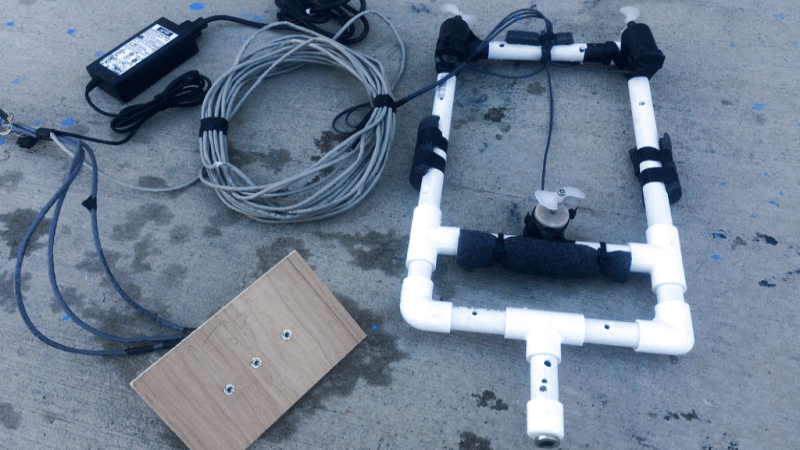[mark.brubaker.1] and his crew decided to make a submersible for a school project using PVC pipes as a frame. It has two motors on the back to provide forward thrust and steering as well as a horizontal mounted motor in the middle of the PVC chassis to provide up and down thrust. They used regular motors which they waterproofed by inserting them inside a case full of plumbers wax. We’re not sure how long this will hold at the bottom of the ocean, but it works fine for a school project in the pool. Here’s the instructions on how to make one.
The build is completely analog, the controller is a board with three switches which individually control the different motors. So if you want to turn left, you fired up the right motor. For right you do the opposite and fire up the left motor. Up and down, well, you get the picture. If you have a swimming pool, lake or some water body nearby and you’re looking for a weekend project with your kids, this is a great tip. It’s not an Arduino controlled robot fish, but it’s a first step in that direction; you can later on use the frame to improve on the design and add some electronics.
They made a video so you can watch it go:
















Super cool. Chassis is a major problem for ROVs and this is a very nice solution.
I like it! How deep can GoPro’s run?
Standard casing should do about 40m according to GoPro, they also sell a divers casing that should do 60m. But I’ve never tested it myself below 10m with the standard casing
Depends. 10m without a housing for some models. The housings in general are good to 75m.
This design is not new (including thruster sealing), it comes from a book about 20 years old called “build your own underwater robot”. As a professional ROV designer, I’ll add that go pros sint go very deep: we’ve helped customers put them in proper underwater housings.
Ugh. Stupid autocorrect. I meant “don’t go very deep”
What would you recommend as a cheap starting platform for a video rov? This PVC-Pipe thing?
Also, what would you recommend for sealing the electric motors?
If you can swing it, a magnetic coupler is pretty good for thruster sealing. At the same time, if the motor will work under pressure (ie the problem is water, not pressure) you can fill the motor housing with low viscosity oil and then pressure compensate the housing (have a flexible rubber blister over a hole in the housing so that the oil in the housing will be at the same pressure as the surrounding water). Then only a low pressure or in seal in the output shafts will do.
As for frame materials, pvc pipe is easy to work with and cheap to get, but I’d prefer side panels rather than a frame made of somewhat flexible tubing.
I’ve seen a lot worse. There’s an international competition for this. http://www.marinetech.org/
If they aren’t already part of it, they should look for a local sponsor
If all they can do is turn the motor ON or OFF, isn’t that purely digital? I guess it’s a trinary system since each motor can go -1,0. and +1…
https://www.flickr.com/photos/gameshints/172841359
The movie spare parts based on some kids or something build one of these I seen this awhile back.
The SeaPerch competition is also very similar.
How about using computer cooling fans for ROV propulsion? Would want to put some water resistant lube on the bearings and seal the electronics with a coating of lacquer. The 4 wire PWM controllable ones would likely be the best.
Fabricate some nose and tail cones to glue onto the motor and blade hubs for streamlining. Also cut away any of the mounting holes not being used to attach the fan to the ROV.
I found Outrunner Brushless Motors (RC Stuff) to Work extremely well. You will need an ESC (Electrical Speed Controller). Those can easily be controlled by Arduino.
I can’t see how wax toilet gasket can insulate a motor. Or was this a removable sealant used tn the PVC assembly?
MATE competition runs similar construction on ROVs. MATE is like FIRST for submersible robots. Funny enough, MATE came before FIRST. ;)
Any ay, a common motor these days is beusless DC from the RC plane, drone world. Essentially magnetic coupling, with no exposed electrical. The winding wire is all insulated. But you have to deal with grime in the open frame motor and rust.
requires presurised air to be stored in the pvc to actuate ballast assistance.
is there a way to make this withstand salt water and make the controls a bit more… controlable?